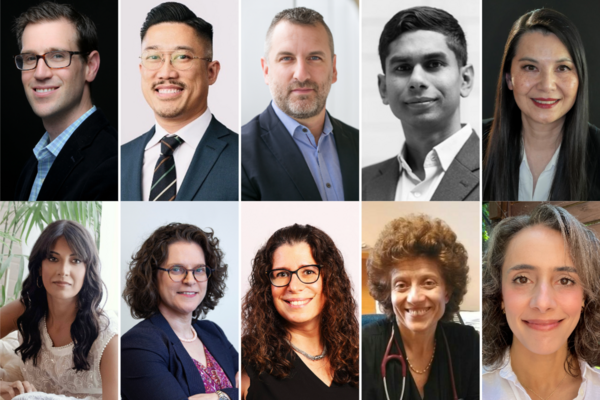Advocating for action: Patient and planetary health

Second in a two-part series on how family physicians can use their clinical practices and professional voices – and choices – to address factors driving climate change and to advocate for the health of patients and the planet.
Read Part 1: Embedding Earth Day thinking and doing into everyday family medicine.
A brief and rapidly closing window of opportunity. That’s the diagnosis from the latest United Nations Intergovernmental Panel on Climate Change report on the impact of the climate crisis and our collective capacity to mitigate and adapt.
It might sound bleak given the biggest levers for change sit beyond our individual reach, but those with trusted voices and prominent roles in their communities – such as family doctors and other health professionals – can help make the case for change.
“Family doctors have a very real role to play as advocates for climate action, particularly given the overlap between policy changes that benefit both planetary and public health,” says Dr. Samantha Green, a family doctor at St. Michael’s Hospital, Unity Health Toronto, and Climate Change and Health Lead in the Department of Family and Community Medicine (DFCM) at the University of Toronto.
“We have the respect, authority and platform to speak out on the climate emergency and climate justice, and it is our responsibility to do so.”
PART 2. ADVOCATING FOR ACTION
In the second set of recommendations, Dr. Green and colleagues highlight the important roles family physicians can, and are, playing as advocates for climate action to limit the harm that climate change inflicts on the health of individuals and populations.
For recommendations #1-6, see Part 1: Embedding Earth Day thinking and doing into everyday family medicine
7. Develop and embed multidisciplinary sustainability teams
To truly embrace sustainable practices in healthcare, sustainability needs to be embedded as part of institutional planning and decision-making, from strategic planning to quality improvement initiatives.
The key is understanding how all team members and patients – not just clinicians – can contribute.
In hospitals, clinics and networks, multidisciplinary sustainability teams can be a great way to share ideas and resources, advocate for new models of care and implement environmentally sustainable practices.
“We've had most success when we have brought in multiple members of our team who see the working of our clinic from different perspectives and can spot different opportunities,” says Dr. Adrian Stacy, a family physician in Simcoe County and faculty with DFCM.
“For example, we’ve been working with our administrative staff and cleaners. Learning their workflow prompted us to transition away from using paper on exam tables and to implement better organic waste collection.”
Dr. Stacy’s next goal is to engage with dietitians and physiotherapists within the family health team and local hospital to promote plant-rich diets and nature prescription programs. As a newcomer to the Simcoe County community, he says this is also a nice way to meet colleagues.
8. Treat climate change as a health emergency
Both the World Health Organization and the Lancet have called climate change the greatest health threat of this century, predicting an additional 250,000 deaths a year from heat stress, malnutrition, dengue and malaria alone from 2030 onward.
While Canada might feel removed from some of the immediate effects of the climate crisis, it is already having a tangible impact on the health of our communities. From wildfires and floods to droughts, food availability, allergies and heat-related illness, climate change is already here.
“Throughout the COVID-19 pandemic we have seen how public policy and individual behaviour can change dramatically in short periods of time to protect the greater good. We need to harness some of that energy to make climate change a priority and make meaningful change happen now,” says Dr. Green.
“As family physicians, talking about the climate crisis, framing it as a health emergency and being willing to lead from the front can help push policy and decision makers in the right direction.”
9. Think beyond our patients to broader public health benefits
As well as counseling individual patients on the personal benefits of climate mitigation activities (see part 1), family doctors can speak publicly and counsel policy makers on similar, public-health level benefits.
“We know that reducing – and ultimately eliminating – fossil fuel use would reduce air pollution, which contributes to an estimated 6,600 premature deaths per year in Ontario alone,” says Dr. Green.
“We must think bigger when it comes to our potential impact as family doctors. Encouraging active transport with our patients is one thing, but advocating for bike lanes and improved access to public transit could make a difference to the health of many, while reducing fossil fuel use and greenhouse gas emissions.”
10. Start talking about climate justice, on Earth Day and every day
Like the COVID-19 pandemic, the climate crisis disproportionately affects the health and welfare of those without the supports or resources required to adapt to a changing environment. This includes people who are Indigenous, racialized, living in poverty, the elderly and many others.
“As clinicians, citizens, community leaders and as teachers, we can and should be using our voices to advocate for those who are marginalized by the society we live in,” says Dr. Green. “The climate crisis is now part of that responsibility.”
“At the most basic level, change begins at home, then at work, then at a system level. It’s time for family doctors to take opportunities on all fronts. The more hands and voices we add to the cause, the better the outcomes will be for our patients and the planet.”
News



